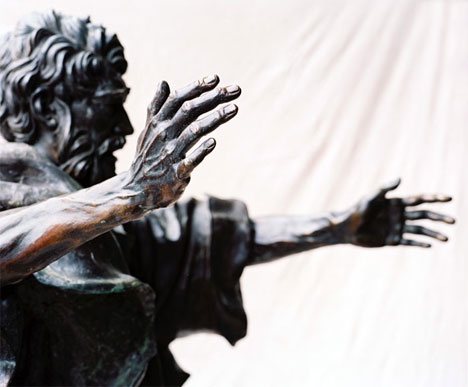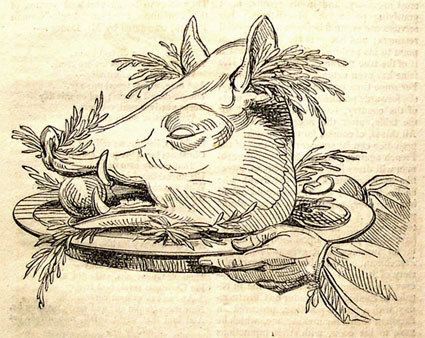Jun
1
2013

How does Peter see the apocalyptic imagery of Joel in the events of Acts 2?
The first step is to take note of the context of Joel’s prophecy. It is the coming destruction of Jerusalem in 586 BC.
And it shall come to pass that everyone who calls on the name of the Lord shall be saved. For in Mount Zion and in Jerusalem there shall be those who escape, as the Lord has said, and among the survivors shall be those whom the Lord calls. (Joel 2:32)
Even if we identify the context, it may sound to us as if Joel is still looking forward to the first century events at the end of his predictions. The unfortunate chapter break between 2 and 3 stops us reading further, but if we keep reading without a break, the beginning of chapter 3 makes it clear that Joel is still speaking about the restoration from exile. God would judge all the Canaanite nations, including Israel, who had behaved like a Canaanite. But only Israel would resurface from the “flood” of Babylonian control, while all the Canaanite powers remained scattered forever. And Israel would be vindicated across the world, from India to Ethiopia, in the events of the book of Esther (predicted in Ezekiel 38-39).
This means that the particular “day of judgment” had already passed by the time Peter quoted the prophet, so he is not quoting the prophecy to announce its soon fulfillment. He is, however, announcing a similar destruction of Jerusalem and its Temple, with all that this entails.
Continue reading
Comments Off | tags: Acts, Joel, Pentecost, Peter | posted in Biblical Theology, Q&A, The Last Days
Oct
10
2011
 .
.
“Rend your heart, and not your garments.” – Joel 2:13
Doug Wilson writes:
True repentance is frequently expressed in a state of consternation. Repentance is not just a state of turning away from sin. It is what happens when someone is given a glimpse of what that sin is actually like. Repentance is not technically turning away from something that was technically wrong. Repentance is actually turning away, with revulsion, from something that is now seen in its true colors. This is why repentance is expressed in consternation.
Continue reading
Comments Off | tags: Doug Wilson, Joel, Justification | posted in Quotes
Sep
5
2011

Joel 2: 1-11
Into Joel again, and he knows nothing of our chapter divisions. At least the chapter break occurs at the end of an obvious stanza. We are still within Ethics 3, so this is the Trumpets stanza of a Trumpets cycle (aren’t fractals fantastic?) It’s a bit like that movie Inception — as the prophecy moves forward, each step is expanded to further level of structure, a dream within a dream. In this case, it is a multi-level nightmare, a brewing, billowing thundercloud. [1]
Jerusalem had become a new Babel, so God raised up a real Babel in order to overrun the Land and swallow her up. Joel uses the Creation, Dominion and Feasts structures but applies them to the invading Babylonians in ironies that would go over our head — if we weren’t familiar with these literary devices!
Continue reading
Comments Off | tags: Babylon, Feasts, Joel, Literary Structure, Minor Prophets, Trumpets | posted in Bible Matrix, Biblical Theology
Aug
23
2011
or Feasts in Joel 1

The prophets were God’s “Covenant sheriffs,” hammering on the door with the broken contract like repo men from hell. They don’t want your car. They want your blood.
It should not surprise us when their words follow the Covenant structure. The first chapter of Joel is, once you know what you are looking at, a beauty and a terror. The prophet uses the Annual Feasts as a theme. It turns out that the Lord’s rebellious people will be the meat on the table.
Continue reading
Comments Off | tags: Feasts, Joel, Literary Structure, Minor Prophets, Systematic typology, Tabernacle, Tabernacles | posted in Bible Matrix, Ethics
Apr
10
2009
 “I know your works: you are neither cold nor hot. Would that you were either cold or hot!
“I know your works: you are neither cold nor hot. Would that you were either cold or hot!
So, because you are lukewarm, and neither hot nor cold, I will spit you out of my mouth.” (Revelation 3:15-16)
In the book of Revelation, many sentences contain multiple Old Testament allusions knotted together. Sometimes these are more obvious (the Judaisers as Babylonian locusts from Joel with long hair added to make them ‘bad Nazirites’, for example), but sometimes they only become apparent from their position within the structure of the passage in question.
Continue reading
Comments Off | tags: Acts, Feasts, James Jordan, Joel, Nazirite, Revelation, Solomon, Tabernacle | posted in Biblical Theology, The Last Days






























